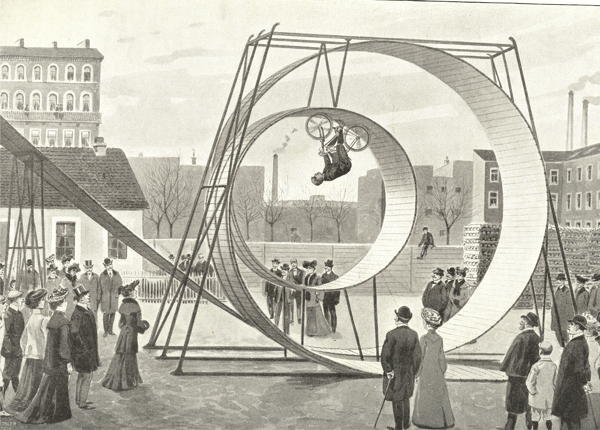TYPES OF BIKES
Classic Bicycles: 1970's to Early 1990's

The majority of bikes hanging around are from this era. They are nearly all made of steel, have horizontal dropouts, and have threaded headsets of various diameters. Bikes from this era were built all over the world, and as such their components have numerous different sets of measurements that can make finding replacement parts difficult. However, the number of older bicycles still in use today is a testament to their durability.
Note: These descriptions are meant to describe the typical setup of each bicycle type. Some bicycles may not fit into any one category, or may not show the key characteristics listed.
Racing Road Bike
The classic road bike shape has been around forever, looks really cool, and has a history stretching back over a hundred years. It was designed to stretch you out, put you in a fairly aggressive position, and had high (read: harder) gears to get you going moving. If you wanna go fast for cheap, get a used one of these in addition to a product certified by your federal government to protect your brain from high-velocity asphalt-mediated injuries.
Key characteristics:
- drop-style handlebars
- skinny tires
- threaded headset
- typically made of steel and in their latter years aluminum
- two high-gear chainrings on the crank
- shifters mounted on the down tube
- earlier models have 27-inch wheels while later models typically have the 700C wheel size
- 126mm rear hub spacing
Sport Road Bike
The sport road bike was the bicycle marketed to the general population. Biking really blew up in the mid 60’s and 70’s, and the market was flooded with bikes that looked like the racing bikes described above but had alterations to make them more friendly for the average person. These bikes were often marketed with a his-and-hers pairing.
Key characteristics:
- either general road bike geometry or “mixte” low top tube
- threaded headset
- handlebars may be typical drop-style or comfortable commuter bars
- two or three rings chainrings on the crank
- earlier models would be outfitted with 27-inch wheels and later models with 700C wheels
- 126mm rear hub spacing
Track Bike
These bikes are the track-specific cousins of the road bike. Tight geometries and the lack of gears make these things a little impractical to ride on anything but a big banked curve. They are usually associated with having a fixed-gear, meaning that the pedal and the rear wheel are directly connected, and whenever the wheel moves so will the pedals - no coasting allowed. Most vintage track bikes you’ll see on the market are actually old sport bikes stripped down and converted to have a single-speed or fixed-gear.
Key characteristics:
- track-style horizontal drop outs
- threaded headset fixed-gear or single-speed
- a front brake or no brakes
- bull horn or track-style drop handlebars
- 110mm or 120mm rear hub spacing
Touring Road Bike
The standard road bike’s meaty cousin, the old school touring bike differs from the old school road bike in a few key aspects. True older touring bikes looked similar to sport road bikes but had a few slight changes in their construction with the idea of carrying loads and being a stable, comfortable platform to bike on all day.
Key characteristics:
- mountain bike-style brakes
- threaded headset
- special fittings to accommodate racks and fenders
- a longer wheelbase for more stable descents
- wide-ranged set of gears
- shifters mounted on the down tube or on the end of the handlebars
- earlier models would be outfitted with 27-inch wheels and later models with 700C wheels
- 126mm rear hub spacing
Mountain Bike
When some bro in Northern California figured that it was pretty fun to start riding bikes up and down hills in the great outdoors, he decided to make a bike specifically for that purpose. Early mountain bike frames basically look like road bikes or cruisers from the same era, but the wheels and handlebars were changed to make them friendlier for all-terrain riding. Older mountain bikes in good shape make great vintage "hybrids" for getting around town.
Key characteristics:
- 26-inch wheels
- threaded headset
- wide knobby tires
- three chainrings on the crank
- flat handlebars as opposed to drop handlebars
- cantilever brakes
- shifters and brake levers both mounted on the handlebars
- 130mm rear hub spacing
Cruiser
The cruiser bicycle is a symbol often associated with the carefree, easygoing attitude of being on da beach. They weigh a hell of a lot, are indestructible, steer like a Cadillac, have a single freewheeling gear, and the brake is often activated by pedaling backwards. Don’t expect to get anywhere fast on one, instead, try to make up the time you’re wasting by enjoying the ride.
Key characteristics:
- 26-inch wheels
- threaded headset
- heavy, curvy steel frames
- coaster/backpedal brakes
- saddle built to accommodate one’s entire butt
- real tall and wide handlebars
- nice big pedals
BMX Bike
These types of bikes were made for the growing number of kids on their Schwinn Stingrays imitating their motocross idols. BMX really took off in the early 80’s, and the some bikes are designed to facilitate performing tricks and stunts while others excel at real BMX dirt racing. Genuine vintage BMX bikes are fairly rare but have a strong group of collectors.
Key characteristics:
- 20-inch wheels
- pegs on trick-specific frames
- squat frame and tall handlebars
- rear or no brakes
